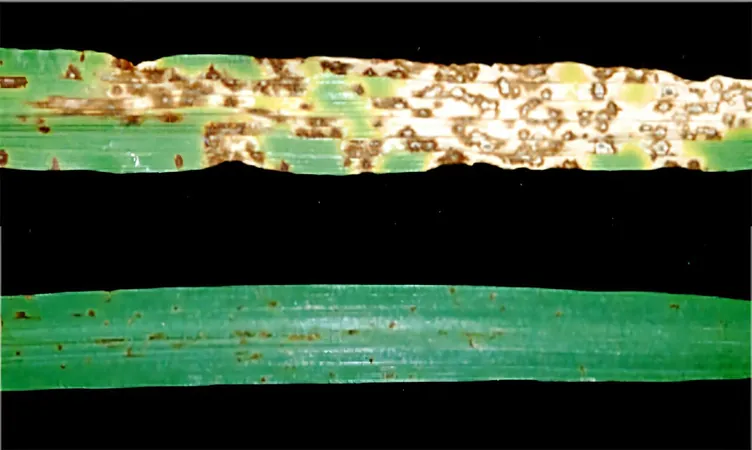
Shocking Discovery: How a Plant Fungus Manipulates Barley’s Immune System!
2024-12-09
Author: Emma
Groundbreaking Research on Barley and Leaf Blotch Disease
A groundbreaking study conducted by researchers in the United States and Germany has unveiled a surprising twist in the battle between barley crops and the deadly leaf blotch disease. Scientists have identified a specific peptide that renders barley—which thrives in the key barley-growing regions of the U.S.—increasingly vulnerable to this crop-threatening contagion.
The Mechanism of Infection
This leaf blotch disease, caused by a necrotrophic fungus, has been a nightmare for barley farmers. The unique fungal peptide cleverly activates a specific immune receptor in barley plants, causing infected cells to perish, thereby weakening the plant's defenses.
Challenges in Barley Breeding Programs
Over the years, barley breeding programs have increasingly integrated multiple immune receptor genes to create varieties that can resist diseases. However, this new discovery reveals that the leaf blotch pathogen has ingeniously exploited this breeding strategy, reversing the intended effect and compromising plant immunity. Farmers, beware! As we focus on resistance to one disease, we risk opening the door to other pathologies that could wreak havoc.
Global Importance of Barley
Globally, barley is a pivotal grain crop, with an astonishing production of 155 million tons annually, primarily used for animal feed. Yet, its susceptibility to various pathogens often leads to catastrophic yield losses—particularly with spot blotch, characterized by dark, chocolate-colored blotches on leaves that lead to desiccation.
Historical Context and Research Background
In the 1990s, a virulent strain of the spot blotch fungus emerged in North Dakota, the heartland of U.S. barley production. To understand the resistance discrepancies among barley plants, researchers led by Shaobin Zhong at North Dakota State University embarked on an ambitious study. They induced random mutations in barley seeds and found that plants resistant to spot blotch shared mutations in a gene named Scs6. Strikingly, transferring this gene to resistant barley caused those plants to become highly susceptible.
Unraveling the Mystery of Scs6 Gene
After decades of research into this virulent strain, the link between susceptibility and the Scs6 gene was established. However, an intriguing question remained: Why does this immune receptor, typically associated with combating living pathogens, contribute to increased susceptibility to a necrotrophic fungus?
Collaboration and Discoveries
Zhong’s team collaborated with Paul Schulze-Lefert’s group at the Max Planck Institute for Plant Breeding Research to solve this mystery. In a pivotal experiment, they uncovered that a unique class of molecules known as non-ribosomal peptides played a key role in the pathogenesis. These peptides not only activate the Scs6 receptor but also trigger a destructive cell death response aimed at thwarting biotrophic pathogens, ultimately aiding the spot blotch fungus instead.
Implications for Future Breeding Strategies
The implications of this research are profound: as barley has been selectively bred for resistance, it has also become a prime target for pathogens that manipulate these immune receptors, resulting in unintended vulnerabilities. As Schulze-Lefert’s group noted, “Evolution has seemingly led some pathogens to hijack host immune receptors, turning the plants' weapons against themselves.”
The Path Forward in Agricultural Research
This startling discovery begs the question: How can the agricultural community adjust its breeding strategies to combat such sophisticated microbial adversaries? The key lies in balancing resistance to multiple diseases while avoiding inadvertent susceptibility—a critical challenge that could shape the future of barley cultivation.
Conclusion: A Critical Challenge for Global Food Security
Stay tuned as this fascinating story unfolds, illuminating the intricate dance between crops and pathogens, and what it means for global food security!









 Brasil (PT)
Brasil (PT)
 Canada (EN)
Canada (EN)
 Chile (ES)
Chile (ES)
 España (ES)
España (ES)
 France (FR)
France (FR)
 Hong Kong (EN)
Hong Kong (EN)
 Italia (IT)
Italia (IT)
 日本 (JA)
日本 (JA)
 Magyarország (HU)
Magyarország (HU)
 Norge (NO)
Norge (NO)
 Polska (PL)
Polska (PL)
 Schweiz (DE)
Schweiz (DE)
 Singapore (EN)
Singapore (EN)
 Sverige (SV)
Sverige (SV)
 Suomi (FI)
Suomi (FI)
 Türkiye (TR)
Türkiye (TR)